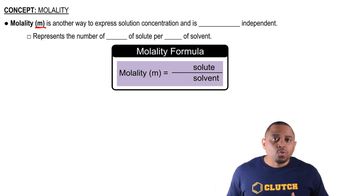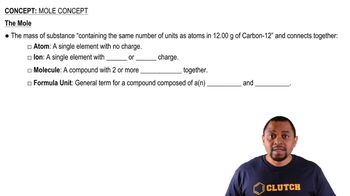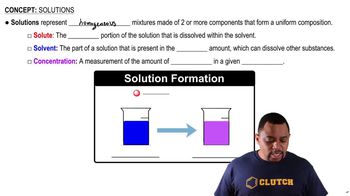Calculate the number of moles of solute present in each of the following aqueous solutions: (c) 124.0 g of a solution that is 6.45% glucose (C6H12O6) by mass.
Ch.13 - Properties of Solutions
Chapter 13, Problem 53b
Describe how you would prepare each of the following aqueous solutions from water and solid KBr: b. 125 g of 0.180 m KBr.
 Verified step by step guidance
Verified step by step guidance1
Calculate the moles of KBr needed: Use the formula for molality, \( m = \frac{\text{moles of solute}}{\text{kg of solvent}} \), to find the moles of KBr required.
Determine the mass of water: Since the solution is 125 g, subtract the mass of KBr from 125 g to find the mass of water.
Convert the mass of water to kilograms: This is necessary because molality is defined in terms of kilograms of solvent.
Weigh the calculated mass of KBr: Use a balance to measure the exact mass of KBr needed.
Dissolve the KBr in water: Add the KBr to the calculated mass of water and stir until the KBr is completely dissolved.

Verified video answer for a similar problem:
This video solution was recommended by our tutors as helpful for the problem above.
Video duration:
3mWas this helpful?
Key Concepts
Here are the essential concepts you must grasp in order to answer the question correctly.
Molarity and Molality
Molarity (M) is a measure of concentration defined as the number of moles of solute per liter of solution, while molality (m) is defined as the number of moles of solute per kilogram of solvent. In this question, the solution is specified in molality, which is important for understanding how to prepare the solution based on the mass of KBr and the mass of water used.
Recommended video:
Guided course

Molality
Calculating Moles
To prepare a solution, it is essential to calculate the number of moles of solute required. The number of moles can be determined using the formula: moles = mass (g) / molar mass (g/mol). For KBr, the molar mass is approximately 119 g/mol, which will be used to convert the mass of KBr into moles for the desired molality.
Recommended video:
Guided course

Mole Concept
Solution Preparation
Preparing a solution involves dissolving a calculated amount of solute in a specific amount of solvent. For a 0.180 m KBr solution, you would need to dissolve the calculated moles of KBr in enough water to achieve the desired molality, ensuring that the total mass of the solvent is accurate. This process requires careful measurement and mixing to ensure uniformity.
Recommended video:
Guided course

Solution Components
Related Practice
Textbook Question
Textbook Question
Calculate the number of moles of solute present in each of the following solutions: (a) 255 mL of 1.50 M HNO3(aq),
Textbook Question
Describe how you would prepare each of the following aqueous solutions from water and the solid solute: a. 1.50 L of 0.110 M (NH4)2SO4 solution;
Textbook Question
Commercial aqueous nitric acid has a density of 1.42 g/mL and is 16 M. Calculate the percent HNO3 by mass in the solution.
Textbook Question
Brass is a substitutional alloy consisting of a solution of copper and zinc. A particular sample of red brass consisting of 80.0 % Cu and 20.0 % Zn by mass has a density of 8750 kg/m3. (a) What is the molality of Zn in the solid solution?
